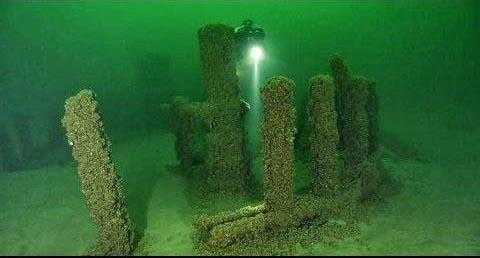Have scientists stumbled across a structure similar to Stonehenge at the bottom of Lake Michigan? Insanely this story is not new, it’s actually old but it went so under reported that nobody knows about it. In 2007, 40 feet below the surface of Lake Michigan where the Grand Traverse Bay Underwater Preserve is, Mark Holley, a professor of underwater archaeology at Northwestern Michigan University College, found the site with his colleague Brian Abbot after voyaging across the lake in a ship that contained sonar equipment, which is generally used to examine old shipwrecks.
After several passes they found a row of stones that piqued their interest. When they sent down divers to visit the site and obtain photographs, they were left somewhat discouraged. “It was really spooky when we saw it in the water,” Holley said. “The whole site is spooky, in a way. When you’re swimming through a long line of stones and the rest of the lake bed is featureless, it’s just spooky.”
In order to satisfy Grand Traverse Bay’s American Indian community, whose interests are to minimize the number of visitors to the site, and to preserve the location of his research, Holley has kept its exact location a secret.

Mark Holley & Mastadon stone.
One of the objects photographed from the site is a boulder which is believed to feature a prehistoric carving of a mastodon — an animal believed to have gone extinct about 10,000 years ago. Researchers shown pictures of the carving have asked for more evidence before they will confirm that the markings are in fact an ancient petroglyph. The trouble is that the boulder is underwater, and experts in petroglyphs aren’t necessarily expert divers.
Holley hopes that a computer model of the carving in the mastodon rock will help petroglyph experts determine whether the features were somehow natural workings or whether they were the work of ancient humans.
A skeptical Charles Cleland, retired curator of Great Lakes archeology and ethnology at Michigan State University, says that petroglyphs are rare int he Upper Midwest but have been seen. Although he is skeptical he does see the value in investigation.
“But I think this is certainly something that needs to be investigated,” Cleland said. “It would be unthinkable to leave it alone and not try to figure it out.”
Interestingly enough, if this structure is authenticated, it may not be all that out of place. Other stone circles and other petroglyph sites have been located in the great lakes, and ancient structures underneath large bodies of water in general are not unusual. There have been over 100 cities at the bottom of the Mediterranean Sea recorded alone, and many more at the bottom of the oceans.
According to geographical history, the submerged site would have been tundra when humans of the hunter-gatherer era roamed it 6,000 to 9,000 years ago. Is is possible the stones came from a massive fishing weir laid across a long-gone river? Or could they maybe mark a ceremonial site? Only time will tell.
But let’s bring up an interesting question… where did all the water come from that covered so many underwater structures?
Think about this for a second: less than 5% of the ocean has been explored and only around 5% of the ocean floor has been mapped! This is truly remarkable when you consider the world’s oceans cover around 70% of the Earth’s surface! Just imagine what we still have left to discover — many ruins, ancient cities, and even pyramids have already been found and we have barely even looked. It seems like the future holds many more amazing discoveries in store for us.
Mark along with his colleague Brain Abbol discovered the site after traveling over the lake in a ship that was equipped with sonar equipment, which usually used to survey old shipwrecks.
As they were passing thru, they found a series of stones that stimulated their interest. When they sent some divers underneath the sea look more and clicked some photographs, they ended up getting disappointed instead.
Holley stated that the stones looked scary when they saw it in the water. The whole place is creepy, scary as in when you are swimming thru a row of stones, and the rest of the lake is empty, it is frightening.
To please Grand Traverse Bay’s American Indian Community, Holley kept the location of Lake Michigan Stonehenge a secret to protect the area of his research. The Grand Traverse Bay’s American Indian Community endeavor to minimize the tourists to the site.
One of the boulder photograph taken at the Lake Michigan stonehenge location is presumed to feature an ancient engraving of a mastodon- an animal that is presumably extinct 10,000 years ago.
Researchers have asked for more substantial proof so that they could validate the markings as a prehistoric petroglyph. Unfortunately, the boulder is beneath the water, and petroglyph experts aren’t much of skilled divers.

Holley expects that a computer model of the monument in the mastodon rock would assist petroglyph experts in deciding whether the features were naturally carved or they were carved during ancient time.
Skeptical Charles Cleland, retired curator of Great lakes archaeology and ethnology at Michigan State University, asserts that petroglyphs are uncommon in the Upper Midwest, however, have seen them. Even though he is skeptical, he does believe in the investigation.

